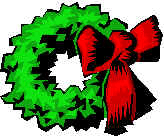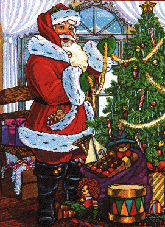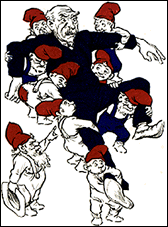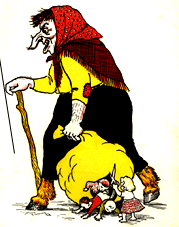 SANTAS
SANTAS SANTAS
SANTAS |
"Santa" is an international traveler with dozens of aliases, including St. Nicholas, Father Christmas, Papa Noel and Kris Kringle. He's Santa Claus, of course, and he's one of the world's most beloved secular symbols of Christmas. |
| Here in Iceland we have our very own version of Santa and according to the Icelandic myth these Santa's were not something you'd want around your house during Christmas. Yes, there are 13 "Jolasveinar" or Christmas boys, as the name might be translated into English. The Icelandic Santa's first appeared in the 17th century as the sons of the two trolls, Gryla and Leppaludi. Gryla and Leppaludi are terribly frightening creatures, and had a reputation for stealing and eating naughty children. The Jolasveinar are supposedly the sons of Gryla and Leppaludi and while their number isn't exact the most common number is thirteen. Their names however are at least 70. The dominant member in the relationship between Gryla and Leppaludi is Gryla who, according to some legends, had another husband before Leppaludi. According to the legends Gryla is unlucky enough to find herself husbands that are constantly bedridden and so, Gryla goes around the countryside finding food for her husbands. At Christmas time she steals children that have been naughty during the year. Through the centuries Gryla has been a very popular means of making children behave. There are numerous legends and stories about Gryla and her exploits, but she never gets her hands on any children. For one reason or another they have either been very well behaved or they manage to escape. |
 |
 |
When they first appeared the Jolasveinar
had many of the attributes of their parents but soon started to seem milder,
and, in the last century, gained some of the attributes of their Nordic
counterparts (i.e. the Christmas elves), and in this century they have
become homegrown versions of Santa Clauses.They supposedly start arriving,
one at a time, 13 days before Christmas, each one wreaking minor havoc
on the Christmas preparations. One, supposedly, would steal the food, one
would mess with the cows, another dirty your clothes and there was
even one who'd steal your candles if he could.
Today they leave little presents for the children in shoes that the children have put on the window sill the night before. Or, if the children have been naughty, they leave a potato, or some other reminder that good behavior is essential around Christmas. Conversely, they start leaving again on Christmas Day, the last one leaving on the Threttandinn, traditionally an Icelandic holiday. |
